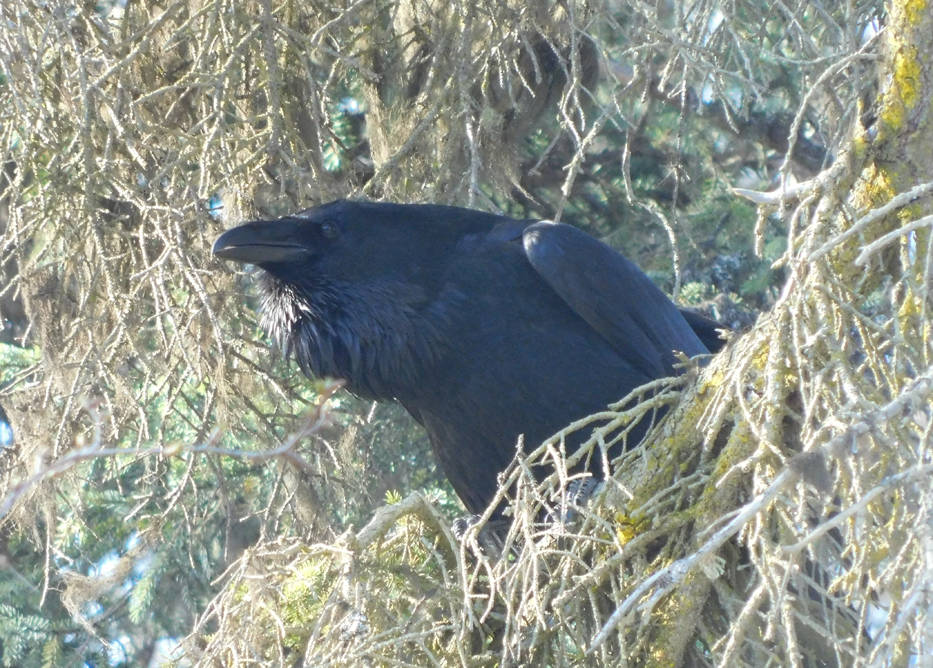I recently had an opportunity to make a quick dash up the Alcan. It has been 25 years since I last drove it and I am always up for an adventure. The trip was exactly as I remembered it — long hours driving, road in “great shape,” Stone Sheep and Wood Bison on the roadways, and scenic views like nowhere else.
It was all the same until we got to a random, snow-covered roadside stop in the middle of the Yukon Territory. We stopped to dig out some snacks when about 100 yards ahead a large bird erupted from the ditch and began flying alongside the road toward us. Immediately following behind was a large Common Raven. At first the escaping bird looked like a grouse, but as it got closer I saw it was an adult male American Widgeon. I was expecting to see the duck zoom away from the raven but, just as the pair winged closer to our vehicle, the raven closed the gap and grabbed ahold of the duck’s wing with its beak.
This was stunning as I have never seen a raven go after a bird this size. They tumbled and hit the ground, with the raven standing on the duck’s back and the duck squirming to get away. The rest of this story may be graphic, but this is truly what transpired and probably the only time in my life that I will ever see such an event. The raven began pecking at the back of the duck’s neck with powerful thrusts. Then it would stop, and pick and twist some skin and feathers off, before resuming the piercing jabs. The duck was beginning to look a little worse for wear but certainly not dead.
The raven dismounted and grabbed the duck in the middle of the neck and began thrashing it back and forth with incredible strength and violence. After flopping the body back and forth 4 or 5 times, it managed to rip the duck’s head off.
That was it for the duck, but the raven had another crafty plan. It walked over into the woods about 30 feet away and stashed the head. It covered it with leaves, moss and snow and then walked back to the remaining carcass. It picked at the open end of the carcass for a few minutes and then flew up to an adjacent tree.
At this point we had to hit the road again, and I am left to guess at what was going through the raven’s mind. In that desolate country where there is such a thin line between life and death, it appeared the raven had previously experienced losing a good portion of its prized catch to other scavengers. In anticipation, it decided to hide the most important part—the brain. I have read that some societies consider brains somewhat of a delicacy, but never thought I would see this behavior from non-human life forms.
So when did Raven the Trickster become Raven the Killer? I have read about ravens as nest predators and scavengers, but have never seen accounts of ravens being able to take down a healthy adult duck capable of sustained flight. In searching for answers to these questions, I find that I may have underestimated the intelligence of the raven. They are considered one of the smartest animals we know, right up there with Chimpanzees and dolphins. Ravens in captivity have been able to talk better than some parrots. There is something very creepy about hearing a raven say “Nevermore.”
In one account, the author described how a raven had hid food in a very obvious way. It turned out the raven was being watched by another raven, so it hid food where it could be seen by the other raven, and then stashed better food in another place while the would-be thief was distracted by the initial, obvious hiding spot. They have also been known to play dead by a beaver carcass in hopes of scaring off other ravens from a delicious find.
Beyond the typical intelligence tests involving tools and complex problems, recent research has found that ravens are capable of planning ahead. Captive birds will select tools they need to solve problems for a large reward in the future rather than select a smaller reward at the time. They even choose delayed gratification and will pass on smaller less-tasty kibble, instead picking a token that can be traded later for a better treat. Hearing them speak human words and plan for a future reward is mind-blowing.
So while I completely underestimated ravens, that encounter at a rest stop in the Yukon has significantly changed my expectations of ravens. Forget my excitement of a raven taking a duck out of mid-air, the bar is set much higher now. I fully expect to see a raven sitting out at my duck blind mimicking duck calls, and either killing the duck itself or waiting for me to do it, knowing its reward will come when I dress the bird out later.
Todd Eskelin is a Wildlife Biologist at Kenai National Wildlife Refuge. He specializes in birds and has conducted research on songbirds in many areas of the state. Find more information at http://www.fws.gov/refuge/kenai/ or http://www.facebook.com/kenainationalwildliferefuge.

